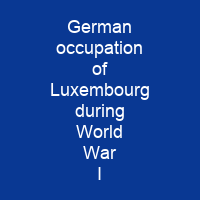Was Luxembourg’s Fate Sealed by Germany’s Ambition?
Imagine a small country caught in the crossfire of history, its fate hanging by a thread during World War I. From August 1914 to November 1918, the Grand Duchy of Luxembourg was under full occupation by the German Empire. This period marked not just a military conquest but also a complex dance between sovereignty and survival.
The Schlieffen Plan: A Prelude to Occupation
Germany’s Schlieffen Plan, designed to launch a lightning attack on France through the Low Countries, set the stage for Luxembourg’s occupation. On August 1, Germany declared war on Russia, and by August 2, German soldiers were crossing into Luxembourg at Remich and Wasserbillig.
Initial Reaction: A Blend of Cooperation and Resistance
The Grand Duchess Marie-Adélaïde ordered her small army not to resist. The German commander, Oberst Richard Karl von Tessmar, met with her and Prime Minister Paul Eyschen on the Adolphe Bridge. Despite this initial cooperation, Luxembourg’s government allowed the occupation while maintaining its own system, a delicate balance that would be tested over time.
Constitutional Turmoil: A See-Saw of Power
The occupation led to a series of short-lived governments and constitutional turmoil after Germany’s withdrawal. The Eyschen government, for instance, faced numerous challenges. When journalist Karl Dardar was arrested for publishing anti-German stories, Eyschen was outraged, telling the German minister that such actions were ‘a direct injury to the Grand Duchy’s national sovereignty.’
Food Crisis and Public Discontent
The food crisis deepened as rationing and price controls were implemented. However, these measures did not address the issue effectively, leading to widespread black market activity. The government lost public trust after Dr Michel Welter was censured by the Chamber of Deputies, leading to his resignation.
Strikes and Suppression: A Test of Will
The strike on May 31, 1917, was put down ruthlessly by German military force. The government’s refusal to allow changes to Article 32, which stated that sovereignty resided in the Grand Duchess, sparked controversy. On September 28, Émile Reuter took over as Prime Minister.
End of Occupation: A New Dawn
The full withdrawal of German soldiers from Luxembourg was announced on October 6, 1918. Five days later, Germany signed an armistice, bringing the war to a close. On November 18, American General John Joseph ‘Black Jack’ Pershing issued a proclamation stating that the United States would liberate Luxembourg as allies and as liberators.
Aftermath: A Path to Independence
The Treaty of Versailles set aside two articles to address concerns for Luxembourg’s status. Article 40 revoked all special privileges Germany had acquired in Luxembourg, with specific renunciations made by Germany. This included withdrawal from the Zollverein and recognition of Luxembourg’s neutrality.
Conclusion
The German occupation of Luxembourg during World War I was a pivotal moment that tested the resilience of its people and government. From initial cooperation to constitutional turmoil, the country navigated through a complex period with remarkable tenacity. The end of the war marked not just an end to occupation but also a new beginning for Luxembourg’s path to independence.

You want to know more about German occupation of Luxembourg during World War I?
This page is based on the article German occupation of Luxembourg during World War I published in Wikipedia (retrieved on November 28, 2024) and was automatically summarized using artificial intelligence.







